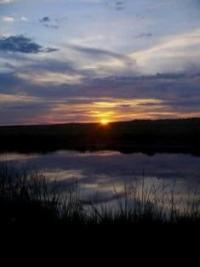You are here
Rivers of Karkaraly park.


Unique nature of Kazakhstan.
"We naturally learn of journeys to unknown lands at the dawn of history only when and where important events were preserved for later generations in images or writings, whether in the form of inscriptions carved on stone and other testimonies, or records made by poets and scholars skilled in the art of writing. However, it goes without saying that both voluntary and forced journeys were made long before this time, perhaps at the dawn of human history."
Richard Hennig. "Unknown Lands."
Sights of nature of Karaganda region.
Physical and Geographical Sketch of Karkaraly Mountains.
Travelers have long written about the charm of mountain lakes and rivers. Mountain streams flow from the mountain peaks in crystal-clear, pristine streams. Lakes are filled with turquoise water, like the cups of a generous host. The tall, fragrant forest is full of mushrooms and berries.
Karkaraly National Park, located in the eastern part of the Kazakh Uplands, is a unique natural area where rivers and streams are a key element of the landscape. Despite the relatively arid climate of Central Kazakhstan, the Karkaraly, Kent, and Shankoz mountain ranges maintain a dense network of streams fed by precipitation, springs, and meltwater from the mountain slopes.
The river network of Karkaraly Park belongs to the Nura River basin and, partially, to Lake Karasor. Most of the rivers are temporary or seasonal, filling with water in the spring and gradually drying up by the end of summer. The catchment area is formed by tectonic depressions and mountain ravines, through which streams flow into numerous lakes, including Bolshoe, Pashennoye, Shaitankol, Komissarovskoye, and others.
Main features of hydrographic network are:
- a high density of temporary streams in the mountainous areas (Karkaraly, Kent, Shankoz);
- a predominance of short rivers and streams (2 to 10 kilometers or more in length);
- a large number of springs with crystal-clear water;
- the presence of channel swamps and small waterfalls, especially in the Tasbulak, Karashoky, Kendara, and Kokshetau valley.
Hydrological regime of rivers of Karkaraly Mountains.
The rivers are primarily fed by snow and rain, fed by springs. Spring flooding begins in late March - early April and lasts for about two weeks. In summer, the water level recedes, leaving only spring areas and streams. In winter, many rivers freeze completely, but in shady gorges, a thin line of water flowing under the ice can be seen – a symbol of the vitality of Karkaraly's nature.
Flora and fauna of coastal ecosystems of Karkaraly Mountains.
Birch, aspen, willow, and elm are found along the riverbanks, as well as rare shrub species such as honeysuckle, cotoneaster, and barberry. Tits, woodpeckers, buntings, frogs, and dragonflies inhabit the coastal grasslands. Some streams are stocked with trout (introduced artificially), and crucian carp and roach are found in the reservoirs of the lower reaches.
Legends and ethnographic motifs ofrivers and streams of Karkaraly Mountains.
According to local legends, each river in Karkaraly has a "soul," and their springs were considered sacred. Elders said that mountain spirits - su iyesi - guard the purity of the springs. The spring at the foot of Mount Kokshetau was especially revered: it is said that if you collect the water at dawn and wash yourself, all worries will be washed away, and your journey will be successful.
Rivers and Streams in Shankoz Mountains.
Aleksandrovsky Stream. The Shankoz Mountains are home to small streams and seasonal, temporary watercourses: the small Aleksandrovsky Stream originates in the northern part of the mountain range. which flows into Zharym Stream, which in turn flows through the Kazakh Uplands and empties into Lake Koytas.
Uzkaya Kendara Stream. From the northeastern slope of Mount Shankoz, 1,360 meters above sea level, flows the 11-kilometer-long Uzkaya Kendara Stream. It originates from springs and is a right tributary of the Aleksandrovsky Stream.
Zharym Stream. From the northern slope of Mount Shankoz, the Kerala Stream originates from springs located on the slope, and extends for 9.5 kilometers to become a left tributary of Zharym Stream.
Zhanabet Stream. From the western slope of the massif, the 9.5-kilometer-long Zhanabet Stream flows into the southern part of the steppe Lake Zhartas.
Kendara Stream. The 21-kilometer-long seasonal Kendara Stream flows from the eastern slope of Mount Shankoz, its waters disappearing into the Zharly-Karasu Valley.
Rivers and Streams in Central Karkaraly Mountains.
The Kuramsa, Koksu, Taldybulak, Karasu, and Kyzylbulak rivers originate from the southern and eastern slopes of the massif. They form narrow mountain valleys with granite ledges and dense vegetation along the banks.
Koksu River, one of the most picturesque, flows from the Mount Kokshetau region and heads southwest, disappearing into the steppe hollows. In the spring, it is full-flowing, its bed filled with a turbulent torrent of meltwater, forming small cascades.
In the eastern part of the park, at the foot of the Karkaraly Mountains, flows the Basaral River, which in the past supplied water to the first forestry areas and settlements. Numerous streams flowing into Lake Bolshoe and Lake Pashennoe also originate here.
Ayanoga Stream. Ayanoga Stream flows from the southern shore of Lake Pashennoe, becoming a left tributary of the Kurozek Stream after 7 kilometers.
Kurozek Stream. The Kurozek Stream flows 21 kilometers from the Karagan tract, located in the northwestern part of Mount Zhirensakal (Komsomol), 1,403.4 meters above sea level, and is a right tributary of the Zharly Stream.
Kengir Stream. The Kengir Stream begins on the spurs of Komsomolsky Peak, heading due east along the Kabanya Shchel valley.
Karkaralinka River. The most significant forest river, the Karkaralinka, is 80 kilometers long. After the confluence of its two sources, the Karkaralinka also receives the left-hand tributaries Tyulkuli and Tasbulak. Cutting into the low hills of Karamurla and Saryzhal, this river rushes toward Lake Karasor.
The Karkaralinka originates from two springs on the eastern slopes of the central Karkaraly Mountains, 2 kilometers from the western edge of the town of Karkaralynsk. The left, more full-flowing branch of the springs includes the Bolshaya and Malaya Karkaralinka, which merge within the town limits.
The right branch contains ravines that dry up in the summer near the Bolshoye Lake. The river flows past Karkaralynsk, past the western end of the Karamyrza Mountains and the eastern part of the Karazhamal Mountains, and skirts the Siyrly Mountains to the west.
It bypasses the village of Akzhol to the west, then flows through Lakes Dat and Kopa, turning west, flowing through the vast Ogizbay ravine, and emptying into the southern part of Lake Karasor, located at an altitude of 622 meters above sea level.
Karaozek Stream. The 20.5-kilometer-long Karaozek Stream flows from the eastern slopes of the Karkaraly Mountains. Passing Shortandy Lake to the west, it becomes a right tributary of the Karkaralinka River.
Tasbulak Stream. The 10-kilometer-long Tasbulak Stream originates from the Tasbulak Gorge, located on the northeastern slope of the Karkaraly Mountains, and soon flows into the Karkaralinka River from the left.
Tulkili Stream. Two kilometers north of the outskirts of Karkaraly, the 9.3-kilometer-long Tulkili Stream originates from numerous springs on the eastern slope of the Karkaraly Massif at an altitude of 1,013 meters above sea level. The intermittent stream flows between the southern outskirts of Karkaraly and the northern shores of Lake Bolshoye, joining the Karkaralinka River from the left.
Karashiliik Stream. The small Karashilik Stream, just over 10 kilometers long, flows from the eastern part of Lake Komisarovskoye and soon takes on the new name of Karasu.
Zhanke Stream. The 8-kilometer-long Zhanke Stream originates on the southern slope of the Karkaraly Mountains, becoming a right tributary of the intermittent Kopa Stream.
Nazar Stream. The small, intermittent Nazar Stream, 14 kilometers long, originates on the southwestern slope just north of the Karatoka cordon. In the Zharla Valley, it flows from the right into the Kopa Stream.
Karasu, Kopa, and Zharly Streams. South of the Karkaraly Mountains flow the Karasu and Kopa Streams, which flow into the larger Zharly Stream. Beyond the village of Komissarovsky, skirting powerful granite outcrops, the stream makes a sharp southward turn and is named the Karasu River.
After 20 kilometers, the Karasu flows into the freshwater Soltankopa Lake. The Zharly River, a full-flowing, fast-flowing river, flows along the western slopes of the Karkaraly Mountains and empties into Lake Karasor.
Rivers and Streams of Kent Mountain Forest.
Kent Mountain Forest has a diverse hydrographic profile, with the following rivers flowing through its gorges: Sarybulak, Muzdybay, Akkiyak, Uzen, Karagash, Kadyr, Bakbay, Kyzylkenysh, and Kyzylashchi. To the east of Karkaraly, approximately 24 kilometers away, lies the Kent mountain forest massif, also rich in streams. The most famous are the Kent, Kzylsu, Ortashokai, and Kyzylkent.
Kent River flows through a wide valley, skirting the mountains of the same name on the northern side. Its banks are dotted with springs and small marshes, where sedge, cattail, marsh marigold, and a variety of moisture-loving plants grow.
In the eastern part of the massif, in the Kzylkent Gorge, among the reddish granite, lies the site of the ancient Kzylkent Palace, near which flows the Kzylsu Stream, known for its clear water and picturesque rapids.
Kyzylkenysh River. The Kyzylkenysh River, which stretches for kilometers, originates in the central part of the Kent mountain massif. 9.2 kilometers from its source, at an altitude of meters above sea level, the river receives a 3.8-kilometer-long tributary from the right, which originates south of Mount Zhamantau, 1,411 meters above sea level.
At 16 kilometers from its source, the river flows through the vicinity of the Tasyrbay burial ground and the Kyzyl-Kent Palace, and skirts the village of Kent on the south side. Near the Tasyrbay vallley, a small tributary of the same name, 3.2 kilometers long, flows into the river. At 23 kilometers, the river flows along the Taldy Valley and, after 28 kilometers, at an altitude of 823.7 meters above sea level, flows into the river of the same name.
Zhamantau Stream. A 10.6-kilometer-long stream of the same name originates on the southern slope of Mount Zhamantau and flows from the right into the Kyzylkenysh River. 6.6 kilometers from its source, a small tributary of the same name, 3 kilometers long, flows into it from the right.
Bakbay Stream. The Bakbay Stream, which stretches for kilometers, originates on the northwestern slopes of the Kent Mountains. At 3.4 kilometers from its source, the full-flowing Akzhal Stream, 7.3 kilometers long, flows into the Bakbay from the left.
The stream originates southwest of Akzhal Mountain, 1,025 meters above sea level. After 6.3 kilometers, the Bakbay Stream takes on a new name, Kospa, and partially disappears into the valley, bends around the Taldy Mountains from the east, and soon becomes a right tributary of the Taldy River.
Ulke Stream. The 28.5-kilometer-long Ulke Stream originates in the central part of the Kent Mountains. The stream originates on the northern side of Naizatas Mountain, 1,326 meters above sea level. After 11.3 kilometers, at an altitude of 866 meters above sea level, the stream forms the main channel of four tributaries.
At 11 kilometers, the stream cuts a narrow valley between the Bassagay Akzhal Mountains to the west and the Sart Mountains to the northeast.
Sarybulak River. One of the longest rivers, the Sarybulak, originates in the eastern part of the Kent Mountains, west of the Kadyr Mountains. The river flows northwest parallel to the Sarybulak Valley and flows from the left into the river of the same name at an altitude of 768 meters above sea level.
Akzharyk River. The longest river, the Akzharyk, originates from the eastern slope of the Kent Massif. It is a 35.5-kilometer-long river and is a left tributary of the Kyzylashta River. At 18.8 kilometers from its source, the river finally forms its main channel, consisting of seven tributaries, at an altitude of 881 meters above sea level.
Eastern Kadyr River. The 30.5-kilometer-long Kadyr Vostochnaya River flows from the eastern slopes of the Kent Mountains and the western slopes of the Kadyr Mountains, flowing from the right into the Akzharyk River.
Tundyk River. The 36.5-kilometer-long Tundyk River originates from the southeastern slopes of the Kent and Kargantas Mountains and the northern slopes of Beldytas Mountain, 1,337 meters above sea level. At 858 meters above sea level, the river flows from the right into the Akzhayryk River.
Sarykorak River. The 32-kilometer-long Sarykorak River originates from the southern slopes of the Kent Massif, from the eastern slopes of Beldytas Mountain, and from the western slopes of the Kokpaktas Mountains. At 889 meters above sea level, it takes its new name, the Kazangap River. The river flows along the western slopes of the Konyrtemershi meridional ridge.
Kazangap River. The Kazangap River, 27 kilometers long, begins its flow from the southern slope of the Kent Mountains. After 16.5 kilometers, the river is renamed Zhangyztobe. At 21.6 kilometers, the river changes its name again, becoming known as Kyugenpiket. The river flows from the left into the Aktailak Stream.
Danabulak River. The Danabulak River, 65 kilometers long, originates in the southern spurs of the Kent Mountains and flows through the gorges in its lower reaches. Aktaylak.
Uzen River. The Uzen River, which stretches for kilometers, originates from the southern spurs of the Kent Mountains. After 19 kilometers from its source, the river is renamed Akkiyak. Under this new name, it flows for another 12 kilometers, joining the Taldy River from the right.
Karagash River. The 22-kilometer-long Karagash River originates from the southern slopes of the Kent Mountains and the western slope of Mount Tursen, 1,469 meters above sea level. Ten kilometers from its source, it passes the Aulietas Mountains, turns southwest, and joins the Taldy River from the right.
Zhalgan Stream. The small Zhalgan River, 8 kilometers long, begins in the Zhalgan Ravine on the eastern slope of the Kent Mountains and becomes a right tributary of the Taldy River.
Practical section for travelers on walks near the rivers of the Karkaraly Mountains.
The best time to observe rivers is spring and early summer, when the streams are full. The Kokshetau, Tasbulak, and Kendara gorges are particularly beautiful, with eco-trails and observation platforms. During the hot season, it's recommended to bring a supply of water, as many riverbeds dry up.
Morning and evening are ideal for photography - the soft light makes the granite banks and clear streams particularly striking.
Conclusion on rivers of Karkaraly Park.
The rivers of Karkaraly Park are not just natural objects, but living threads linking time and landscapes. They emerge from granite boulders, flow through green valleys, and disappear into the steppe expanses, preserving the spirit of ancient Kazakhstan.
Each stream is like a melody, inscribed in the mountain silence, and anyone who has heard it will never forget the voice of water in the Karkaraly mountains.
Authority and photos by:
Alexander Petrov.







